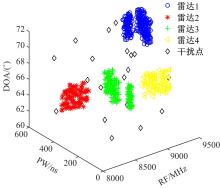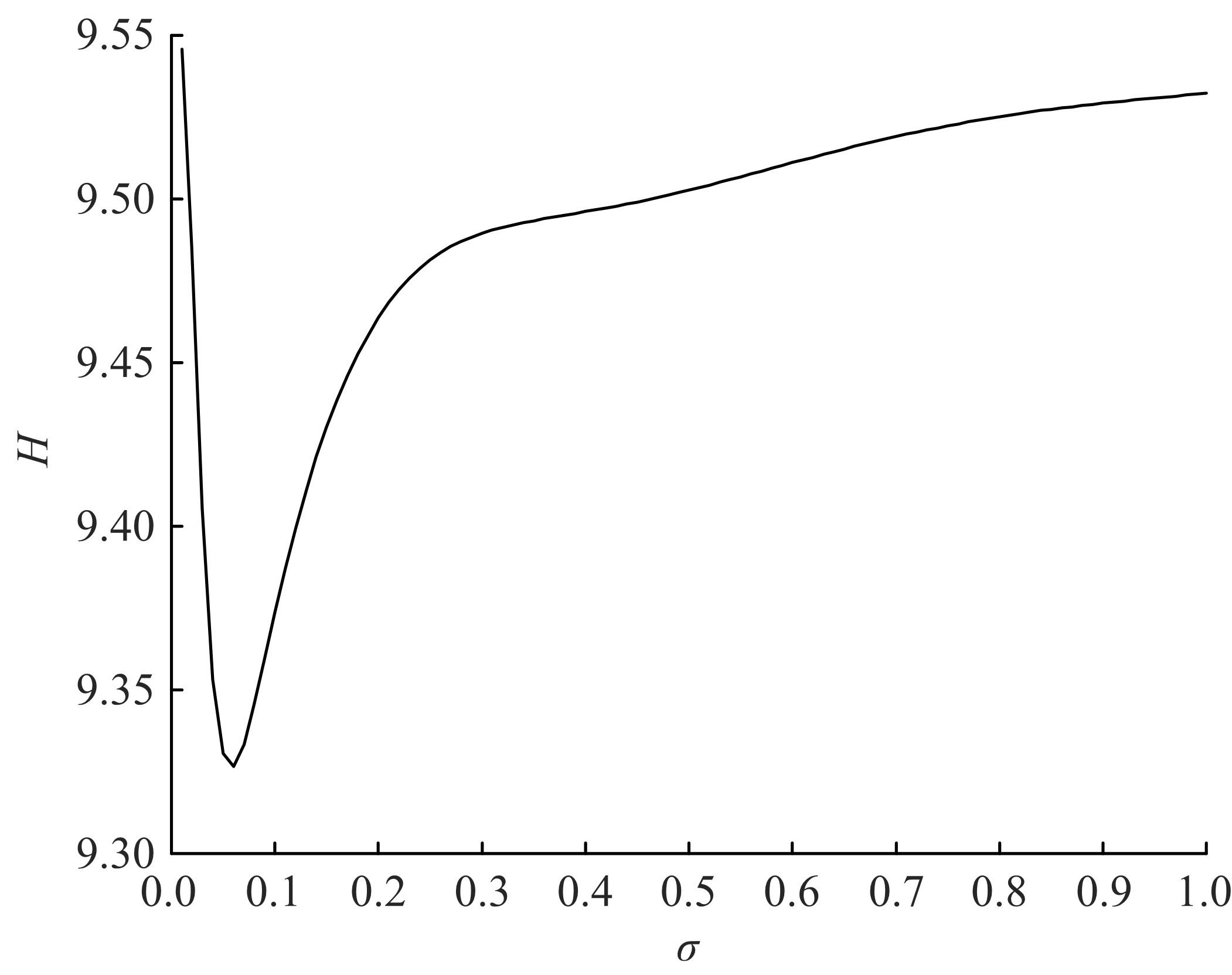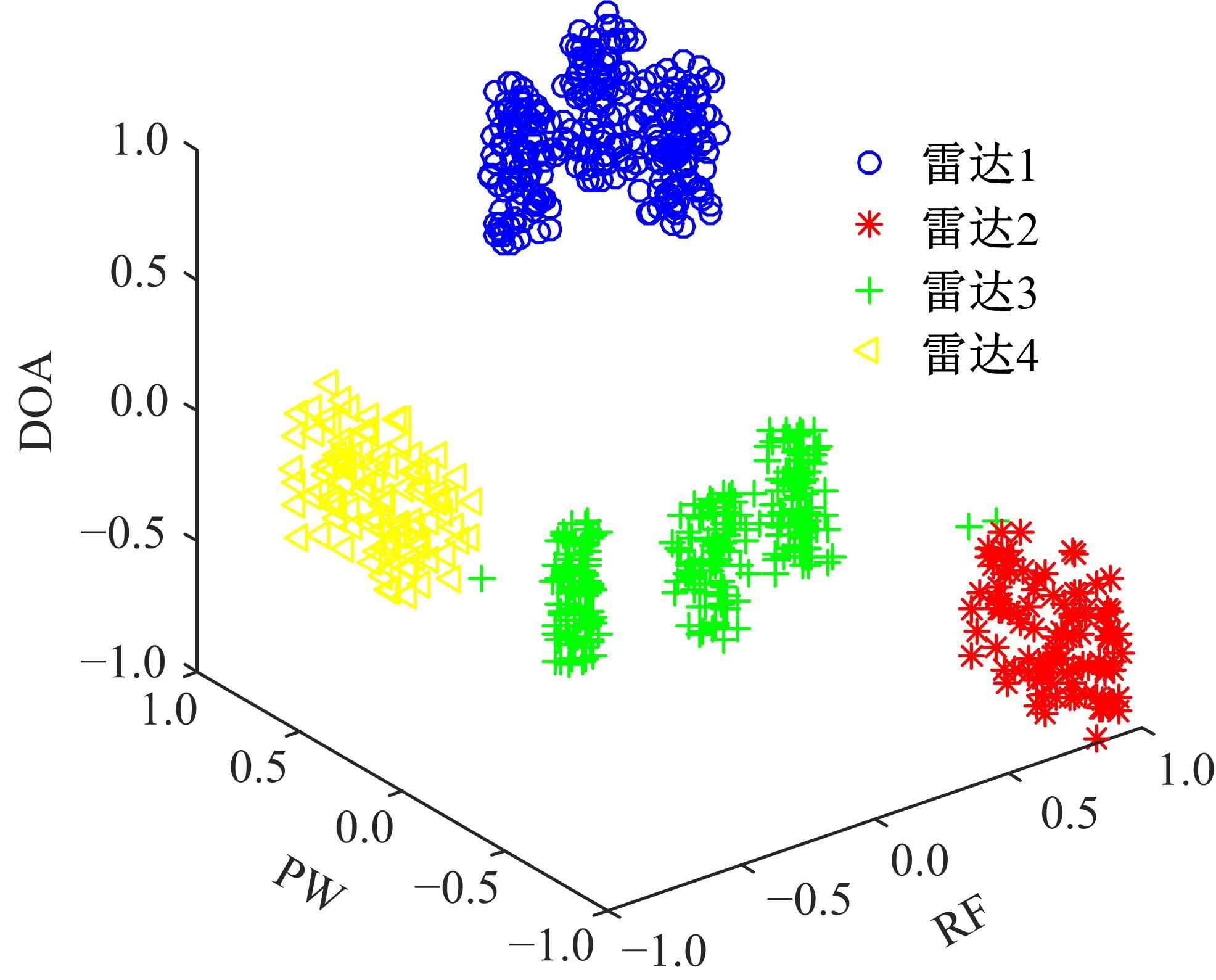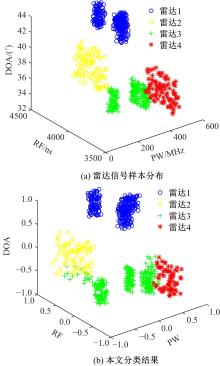Journal of Jilin University(Engineering and Technology Edition) ›› 2022, Vol. 52 ›› Issue (8): 1904-1911.doi: 10.13229/j.cnki.jdxbgxb20210173
Multi⁃mode radar signal sorting based on potential distance graph and improved cloud model
Qiang GUO( ),Ming-song LI,Kai ZHOU
),Ming-song LI,Kai ZHOU
- College of Information and Communication Engineering,Harbin Engineering University,Harbin 150001,China
CLC Number:
- TN957.5
| 1 | 冯鑫,胡晓曦,匡银. 基于数据场的多模雷达信号分选算法[J]. 电子设计工程, 2018, 26(23): 139-142. |
| Feng Xin, Hu Xiao-xi, Kuang Yin. The research of sorting method for multimode radar signal based on data field[J]. Electronic Design Engineering, 2018, 26(23): 139-142. | |
| 2 | 赵葆昶, 彭世蕤, 郁春来, 等. 基于相参特性的雷达信号分选中“增批”问题研究[J]. 现代防御技术, 2011, 39(4): 70-74. |
| Zhao Bao-chang, Peng Shi-rui, Yu Chun-lai, et al. Research on increasing-batch problem in the progress of sorting of signals based on coherency[J]. Modern Defence Technology, 2011, 39(4): 70-74. | |
| 3 | 刘丽明,陈正宁,姚啸. 基于DBSCAN算法的PDW数据二次分选方法研究[J]. 舰船电子对抗, 2019, 42(2): 80-83. |
| Liu Li-ming, Chen Zheng-ning, Yao Xiao. Research into second sorting method of PDW data based on DBSCAN algorithm[J]. Shipboard Electronic Countermeasure, 2019, 42(2): 80-83. | |
| 4 | 刘明. 一种改进的基于PRI参数的雷达信号分选算法[J]. 舰船电子工程, 2018, 38(2): 65-68, 73. |
| Liu Ming. An improved radar signal sorting algorithm based on PRI parameter[J]. Ship Electronic Engineering, 2018, 38(2): 65-68, 73. | |
| 5 | 袁泽恒,袁如月. SVM分类器设计在雷达信号分选中的应用[J].电子信息对抗技术, 2018, 33(6): 33-37. |
| Yuan Ze-heng, Yuan Ru-yue. Application of SVM classifier design in radar signal sorting[J]. Electronic Information Warfare Technology,2018,33(6): 33-37. | |
| 6 | 郭立民,陈鑫,陈涛. 基于AlexNet模型的雷达信号调制类型识别[J].吉林大学学报: 工学版, 2019, 49(3): 1000-1008. |
| Guo Li-min, Chen Xin, Chen Tao. Radar signal modulation type recognition based on AlexNet model[J]. Journal of Jilin University(Engineering and Technology Edition), 2019, 49(3): 1000-1008. | |
| 7 | 徐卓君, 杨雯婷, 杨承志, 等. 雷达脉内调制识别的改进残差神经网络算法[J].吉林大学学报: 工学版, 2021, 51(4): 1454-1460. |
| Xu Zhuo-jun, Yang Wen-ting, Yang Cheng-zhi, et al. Improved residual neural network algorithm for radar intrapulse modulation classification[J]. Journal of Jilin University(Engineering and Technology Edition), 2021, 51(4): 1454-1460. | |
| 8 | Ahmed M G S, Tang B. Sorting radar signal from symmetry clustering perspective[J]. Journal of Systems Engineering and Electronics, 2017, 28(4): 690-696. |
| 9 | 黄岚, 李玉, 王贵参, 等. 基于点距离和密度峰值聚类的社区发现方法[J]. 吉林大学学报: 工学版, 2016, 46(6): 2042-2051. |
| Huang Lan, Li Yu, Wang Gui-shen, et al. Community detection method based on vertex distance and clustering of density peaks[J]. Journal of Jilin University (Engineering and Technology Edition), 2016, 46(6): 2042-2051. | |
| 10 | 淦文燕, 李德毅, 王建民. 一种基于数据场的层次聚类方法[J]. 电子学报, 2006(2): 258-262. |
| Gan Wen-yan, Li De-yi, Wang Jian-min. An hierarchical clustering method based on data fields[J]. ACTA Electronica Sinica, 2006(2): 258-262. | |
| 11 | 李延, 王大魁, 耿晶, 等. 数据质量聚类算法[J]. 武汉大学学报: 信息科学版, 2019, 44(1): 153-158. |
| Li Yan, Wang Da-kui, Geng Jing, et al. Data quality clustering[J]. Geomatics and Information Science of Wuhan University, 2019, 44(1): 153-158. | |
| 12 | 翁永祥, 赵万磊, 郑志娟. 基于PCA联合K-Means聚类的雷达信号分选算法[J]. 舰船电子对抗, 2020, 43(2): 38-42, 60. |
| Weng Yong-xiang, Zhao Wan-lei, Zheng Zhi-juan. Radar signal sorting algorithm based on PCA combined K-means clustering[J]. Shipboard Electronic Countermeasure, 2020, 43(2): 38-42, 60. | |
| 13 | 李德毅, 孟海军, 史雪梅. 隶属云和隶属云发生器[J]. 计算机研究与发展, 1995, 6: 15-20. |
| Li De-yi, Meng Hai-jun, Shi Xue-mei. Membership cloud and membership cloud generator[J]. Computer R&D, 1995, 6: 15-20. | |
| 14 | 陈昊,李兵,刘常昱.一种无确定度的逆向云算法[J]. 小型微型计算机系统, 2015, 36(3): 544-549. |
| Chen Hao, Li Bing, Liu Chang-yu. An algorithm of backward cloud without certainty degree[J]. Journal of Chinese Computer Systems, 2015, 36(3):544-549. | |
| 15 | 刘桂花, 宋承祥, 刘弘. 云发生器的软件实现[J]. 计算机应用研究, 2007(1): 46-48. |
| Liu Gui-hua, Song Cheng-xiang, Liu Hong. Software Implementation of Cloud Generators[J]. Application Research of Computers, 2007(1): 46-48. | |
| 16 | 张怡霄,郭文普,康凯, 等. 基于数据场联合PRI变换与聚类的雷达信号分选[J]. 系统工程与电子技术, 2019, 41(7): 1509-1515. |
| Zhang Yi-xiao, Guo Wen-pu, Kang Kai, et al. Radar signal sorting method based on data field combined PRI transform and clustering[J]. Systems Engineering and Electronics, 2019, 41(7): 1509-1515. | |
| 17 | Wan J, Nan P L, Guo Q, et al. Multi-mode radar signal sorting by means of spatial data mining[J]. Journal of Communications and Networks, 2016, 18(5): 725-734. |
| [1] | Hong-xue LI,Shi-wu LI,Wen-cai SUN,Wei LI,Meng-zhu GUO. Driving cycle construction of heavy semi⁃trailers carrying hazardous cargos [J]. Journal of Jilin University(Engineering and Technology Edition), 2021, 51(5): 1700-1707. |
| [2] | Li-qun WU,Liang-liang ZHANG. Health detection of bridge structures based on data mining technology [J]. Journal of Jilin University(Engineering and Technology Edition), 2020, 50(2): 565-571. |
| [3] | LIU Zhe, XU Tao, SONG Yu-qing, XU Chun-yan. Image fusion technology based on NSCT and robust principal component analysis model with similar information [J]. Journal of Jilin University(Engineering and Technology Edition), 2018, 48(5): 1614-1620. |
| [4] | ZHANG Man, SHI Shu-ming. Analysis of state transition characteristics for typical vehicle driving cycles [J]. 吉林大学学报(工学版), 2018, 48(4): 1008-1015. |
| [5] | GENG Qing-tian, YU Fan-hua, WANG Yu-ting, GAO Qi-kun. New algorithm for vehicle type detection based on feature fusion [J]. 吉林大学学报(工学版), 2018, 48(3): 929-935. |
| [6] | SU Chang, FU Li-ming, WEI Jun, LI Shuo, HUANG Lei, CAO Yue. Design method in exterior color based Kansei engineering and principal component analysis [J]. 吉林大学学报(工学版), 2016, 46(5): 1414-1419. |
| [7] | MA Shuang, ZHOU Chang-jiu, ZHANG Lian-dong, HONG Wei, TIAN Yan-tao. Twist-lock online recognition based on improved incremental PCA by Kinect [J]. 吉林大学学报(工学版), 2016, 46(3): 890-896. |
| [8] | QIU Chun-ling, TAO Qiang, FAN Run-long, WANG Pei-zhi. Zircon image matching method based on description of SIFT feature by LBP [J]. 吉林大学学报(工学版), 2014, 44(6): 1793-1798. |
| [9] | GU Bo-yu,SUN Jun-xi,LI Hong-zuo,LIU Hong-xi,LIU Guang-wen. Face recognition based on eigen weighted modular two-directional two-dimensional PCA [J]. 吉林大学学报(工学版), 2014, 44(3): 828-833. |
| [10] | SONG Huai-bo, SHI Jian-qiang. Pose estimation of varied human faces based on PCA method [J]. 吉林大学学报(工学版), 2013, 43(增刊1): 43-46. |
| [11] | BAO Lei, XU Qi-zhi. Spectrum-keeping algorithm for fusing based on PCA [J]. 吉林大学学报(工学版), 2013, 43(增刊1): 88-91. |
| [12] | WANG Zhuo-zheng, JIA Ke-bin. Application of matrix completion and principal component analysis to corrupted image registration [J]. 吉林大学学报(工学版), 2013, 43(增刊1): 78-83. |
| [13] | LIU San-min, SUN Zhi-xin. P2P traffic identification based on support vector data description [J]. , 2012, 42(04): 947-951. |
| [14] | WANG Yan-hui, GUO Kong-hui, LU Bing-wu, YING Guo-zeng, QIN Min. Method of the vehicle's handling and stability objective evaluation based on multi-variate statistical analysis [J]. 吉林大学学报(工学版), 2011, 41(增刊2): 6-11. |
| [15] | LI Ying, GONG Hong-Li, LIANG Jia-Xi, ZHANG Yan-Ning. SAR image target feature extraction based on KSVD and PCA [J]. 吉林大学学报(工学版), 2010, 40(05): 1336-1339. |
|
||









